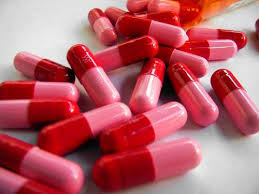 After two days off of school, our pediatrician confirmed what I had already suspected—The Girl One has strep throat. Poor little booger!
After two days off of school, our pediatrician confirmed what I had already suspected—The Girl One has strep throat. Poor little booger!
Recommended course of action? Antibiotics.
Now, anyone that knows me well knows that I’m not a big fan of antibiotics. The diagnosis was backed up with a throat swab, however, and penicillin is an accepted and effective treatment for such an infection.
I love my daughter’s pediatrician, not only because she’s a sweetheart, but also because she does not hand out antibiotics at the drop of a hat. This was not always the case, unfortunately. In the past, The Girl One was over-prescribed antibiotics by her former pediatrician for everything from ear infections to a bad cold. Being a new mother, I trusted the doctor and just went with it.
It wasn’t until a few years ago, when my daughter was hospitalized with a serious antibiotic resistant staph infection after a cystic hygroma removal surgery, that I really started to wonder if all those antibiotics were such a good idea. Normal first line of defense antibiotics did nothing for her infection, nor did other slightly more potent antibiotics. In the end it took a combination of vancomycin and another one of the strongest antibiotics that the hospital had on hand to finally treat the infection.
It was the scariest couple weeks of my life, but it also opened my eyes to the dangers of the over-use of antibiotics. Ever since then, I’ve been a pretty big stickler on just when and how my children use antibiotics.
Taking antibiotics properly can help ensure that the medication does its job properly and effectively kills all of the nasty little bugs. It can also help ensure that you or your little one don’t end up back in the hospital due to complications.
If you or your little one are stuck with taking antibiotics, here are some do’s and dont’s you’ll want to keep in mind…
DON’T take antibiotics if you don’t need them.
Antibiotics kill bacteria, not viruses, and many common ailments, such as the common cold and influenza, are caused by viruses. Taking antibiotics for a viral infection could do nothing,make your illness worse, or even help contribute to the creation of a nasty antibiotic-resistant bug. Always make sure that you’re battling a bacterial infection before taking antibiotics.
DO ask your doctor questions.
If you have any questions or concerns about being prescribed antibiotics, do make sure that you have a chat with your doctor. You may want to ask why you need an antibiotic, how to take it, and what side effects you can expect. Also, don’t be afraid to ask if a laboratory test might be necessary to confirm the diagnosis.
DON’T stop taking the drug when you feel better.
Follow the directions for taking the antibiotic exactly. This means that you must take all of the prescribed antibiotic for the recommended time to kill all of the bacteria, even if you begin to feel better. You shouldn’t have any antibiotic leftover.
DO take antibiotics with water.
Water can help reduce side effects of antibiotics, such as upset stomach. Drinking a full glass of water with your antibiotics can also help the medication absorb into you body and reduce the likelihood of kidney or liver complications.
DON’T eat or drink certain things when taking antibiotics.
Some foods or drinks can actually hinder absorption of certain antibiotics. When taking antibiotics, avoid acidic food and drink, milk, and high-fiber foods.
DO shake antibiotic oral suspensions well.
Most children are prescribed a liquid antibiotic, known as an oral suspension. These should be shaken well to evenly distribute the medication throughout the suspension. Otherwise, you run the risk of having too little antibiotic in the first doses and too much in later doses.
DON’T take some antibiotics with food.
Some antibiotics do not absorb into the bloodstream as well when taken with food. This means that the medication is not able to do its job as intended. Antibiotics that should not be taken with food include ampicillan, ciprofloxacin, doxycycline, and tetracycline. Take these antibiotics two hours before or four hours after eating.
DO take some antibiotics with food.
Other antibiotics absorb into the bloodstream better when taken with food. Taking an antibiotic with food can also help reduce upset stomach. These include Augentin, nitrofurantoin, and metronidazole. If in doubt, ask your doctor if your antibiotic should be taken with food.
DON’T mix antibiotics with some medications, vitamins, or herbal supplements.
Always tell your doctor if you are taking any medications, vitamins, or herbal supplements. Even some seemingly harmless supplements can interfere with antibiotics. Calcium and iron, for instance, can decrease the effectiveness of some antibiotics. Mixing anibiotics with some other prescription medications can also reduce the effectiveness of either drug or cause side effects.
DO watch for sign of antibiotic allergies.
Some people are highly allergic to certain antibiotics, so it’s important to keep an eye out for symptoms of a possible allergy. This is especially true if it’s the first time an antibiotic has been prescribed. Signs and symptoms of an antibiotic allergy usually occur within an hour of taking the drug and can include:
- Rash or Hives
- Itching
- Fever
- Swelling
- Shortness of breath
- Wheezing
- Runny nose
- Itchy, watery eyes
- Abdominal pain
- Vomiting
- Diarrhea
- Bloody stool
Discontinue using the drug and contact your doctor immediately if you suspenct an antibiotic allergy.






